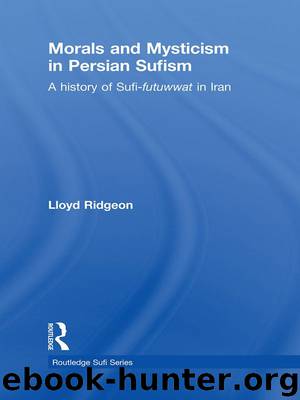Morals and Mysticism in Persian Sufism: A History of Sufi-Futuwwat in Iran (Routledge Sufi Series) by Lloyd Ridgeon

Author:Lloyd Ridgeon [Ridgeon, Lloyd]
Language: eng
Format: azw3
Tags: Humanities
Publisher: Taylor and Francis
Published: 2010-06-10T04:00:00+00:00
The occupational associations
The section above has discussed the linkage of futuwwat with certain professions, and the most distinguishing feature of Kshif’s work is that it is one of the first accounts that explicitly links futuwwat as a social organisation with crafts, although links between the two have been suggested at a much earlier stage in Iranian history. 68 From the Sufi perspective, the connection between futuwwat and occupational associations is of interest because of the theoretical tensions that plagued earlier manifestations of Sufism about the permissibility of Sufis becoming engaged in full-time employment. Some of the early Sufi masters of the “Iraq-oriented” Sufis “generally maintained a thorough distrust of earning a living,” 69 whereas the Malmats associated freely with the people of the bazaar in an attempt to “lose” themselves and be considered “normal” people as opposed to becoming recognised as Sufis and therefore open to a different kind of treatment. From a relatively early period, then, there appears to be some connection between forms of spirituality and crafts, although the evidence is far from clear. In the “formative period” of Sufism, there were some eminent Sufis who continued to doubt the spiritual value of certain occupations, at least.
The Futuwwat nma-yi is composed of seven parts, 70 the final two of which are both concerned with explaining aspects of jawanmard that pertain to individuals in occupations “on the field of trial” (part six) and “those using handgrips” (part seven). In effect, parts six and seven focus on certain sectors of society that are engaged in various aspects of work, some manual, others what might be termed entertainment and worship. Perhaps the plan for parts eight to twelve included other occupations, but unfortunately Kshif left no indication of the contents of the “missing” parts. The professions on the field of trial include the orators (ahl-i sukhan) who enjoy the highest standing among the adherents of futuwwat, the strongmen (ahl-i zr) and the players (ahl-i bz). The orators are the eulogisers who recite poetry, or who recite poetry and versified stories of miracles and virtues, and those who recite prose and poetry mixed together. Also included within the eulogisers are the water bearers, hawkers and vendors, storytellers and fabulists. The strongmen are composed of the wrestlers, the dumbbell lifters, hod carriers, basket carriers, porters, mace wielders, rope dancers and strong men. The players are composed of jugglers, puppeteers and conjurors. Within this category of individuals on the field of trial, Kshif included a wide variety of occupations that pertain largely to what might be considered by contemporary standards the more manual and less economically sound workers in society. However, as Keyvani has indicated, the distinction between high and low occupations “depended to a great extent on the religious and moral qualities which Islamic laws and traditions ascribed to its trades and occupations.” 71 Nevertheless, however pious and upright the performers may have been, another criterion for social status and esteem among the occupations was the degree of skill and length of experience required.
Download
This site does not store any files on its server. We only index and link to content provided by other sites. Please contact the content providers to delete copyright contents if any and email us, we'll remove relevant links or contents immediately.
| Anthropology | Archaeology |
| Philosophy | Politics & Government |
| Social Sciences | Sociology |
| Women's Studies |
Cecilia; Or, Memoirs of an Heiress — Volume 1 by Fanny Burney(32078)
Cecilia; Or, Memoirs of an Heiress — Volume 3 by Fanny Burney(31470)
Cecilia; Or, Memoirs of an Heiress — Volume 2 by Fanny Burney(31420)
The Great Music City by Andrea Baker(30797)
We're Going to Need More Wine by Gabrielle Union(18645)
All the Missing Girls by Megan Miranda(14798)
Pimp by Iceberg Slim(13803)
Bombshells: Glamour Girls of a Lifetime by Sullivan Steve(13701)
Fifty Shades Freed by E L James(12927)
Talking to Strangers by Malcolm Gladwell(12889)
Norse Mythology by Gaiman Neil(12862)
For the Love of Europe by Rick Steves(11564)
Crazy Rich Asians by Kevin Kwan(8901)
Mindhunter: Inside the FBI's Elite Serial Crime Unit by John E. Douglas & Mark Olshaker(8725)
The Lost Art of Listening by Michael P. Nichols(7170)
Enlightenment Now: The Case for Reason, Science, Humanism, and Progress by Steven Pinker(6881)
The Four Agreements by Don Miguel Ruiz(6328)
Bad Blood by John Carreyrou(6286)
Weapons of Math Destruction by Cathy O'Neil(5852)
